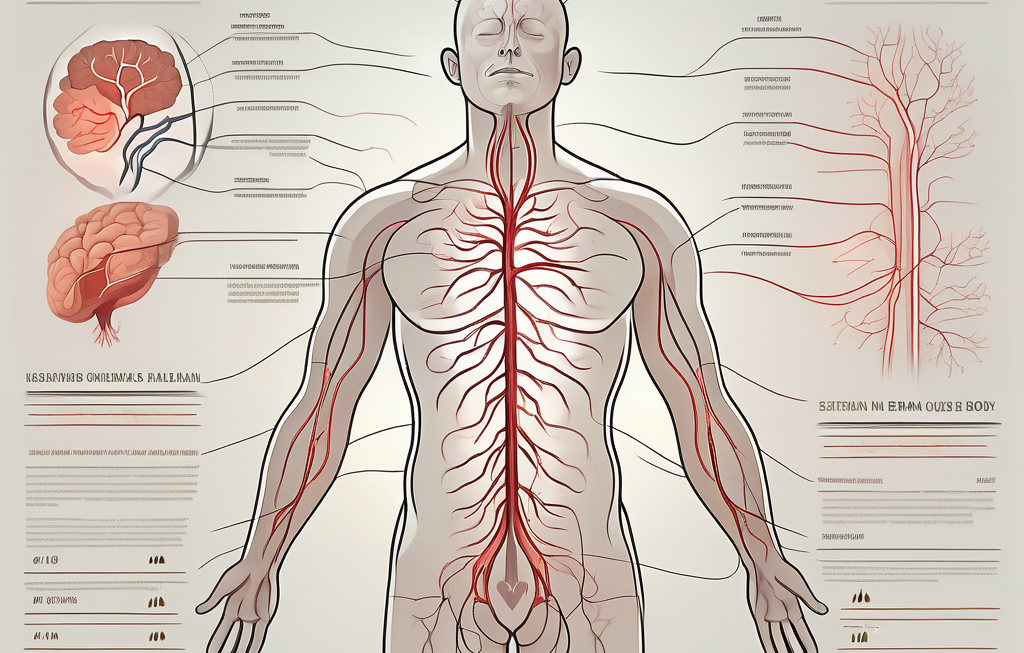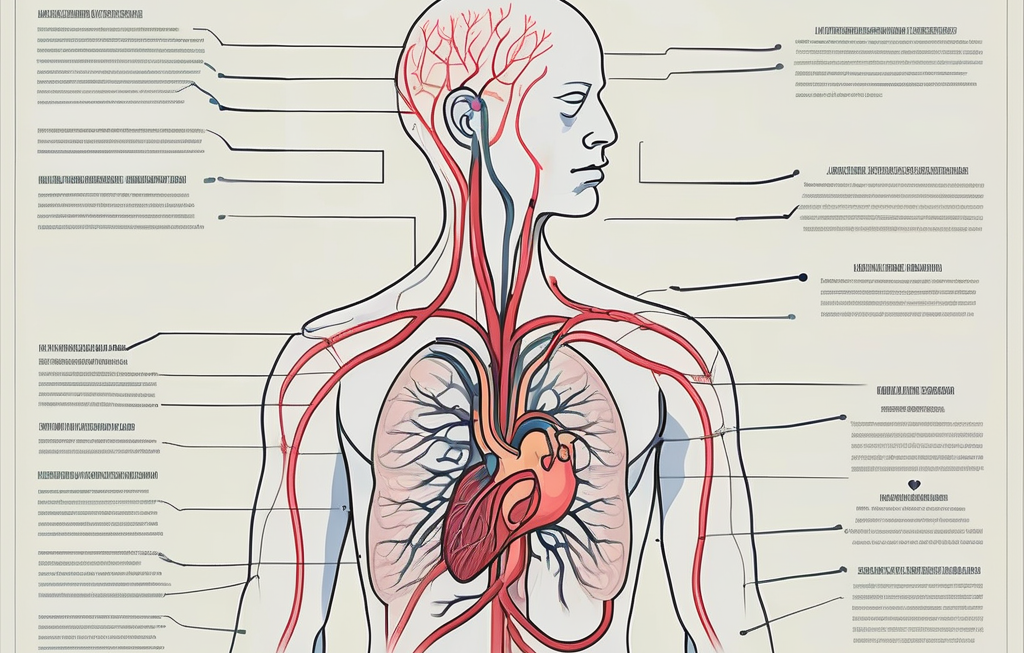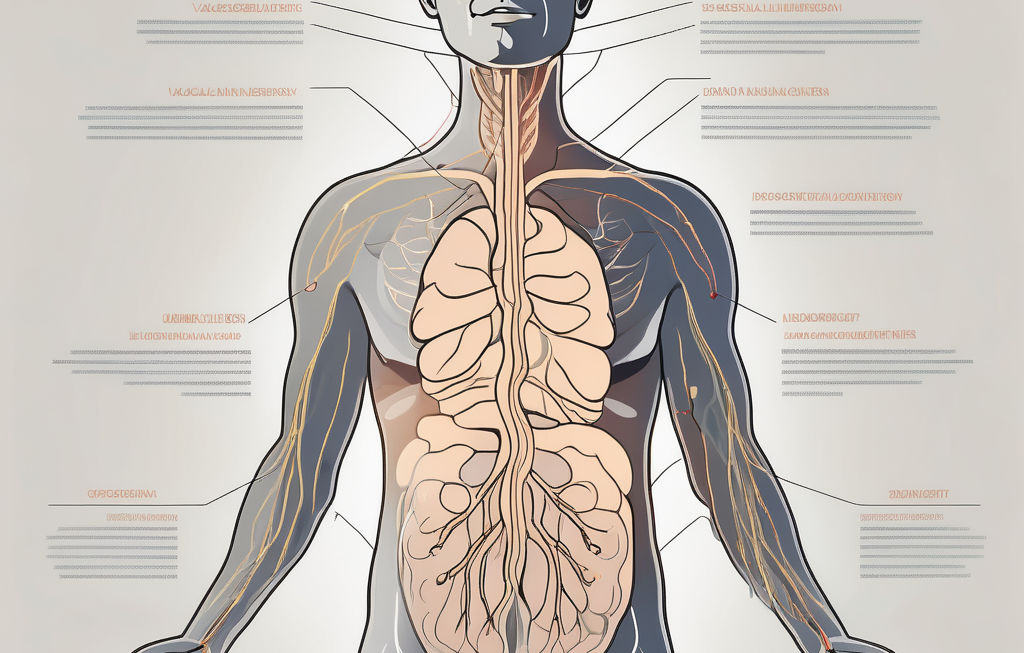The vagus nerve, also known as the “wandering nerve,” is a vital part of our body’s nervous system. It plays a significant role in regulating many essential functions, including digestion, heart rate, and even our stress response. Understanding the vagus nerve and its functions can help us better appreciate its importance in maintaining our overall well-being.
Understanding the Vagus Nerve
The Role of the Vagus Nerve in the Body
The vagus nerve is one of the most fascinating components of the human nervous system. It is a remarkable structure that plays a crucial role in regulating numerous bodily functions. Originating from the brainstem and extending down through the neck, chest, and abdomen, the vagus nerve is a lengthy and intricate pathway consisting of thousands of nerve fibers.
Aside from its involvement in the parasympathetic nervous system, the vagus nerve also plays a significant role in the body’s inflammatory response. It is known to modulate inflammation by interacting with immune cells, thereby influencing the body’s immune response. This dual functionality highlights the vagus nerve’s versatility in maintaining homeostasis and overall well-being.
One of the primary roles of the vagus nerve is to regulate the parasympathetic nervous system, often referred to as the “rest and digest” response. When activated, the vagus nerve slows down our heart rate, stimulates digestion, and promotes relaxation. It helps us recover from moments of stress and puts our body into a state of calm.
Anatomy of the Vagus Nerve
The vagus nerve is a marvel of biological engineering, comprising both sensory and motor fibers that work in harmony to ensure seamless communication between the brain and various organs. The sensory fibers play a crucial role in transmitting essential information from the organs and tissues to the brain, providing valuable feedback about their functioning.
On the other hand, the motor fibers of the vagus nerve are responsible for stimulating the organs and tissues, enabling them to carry out their specific functions effectively. This intricate interplay between sensory and motor components highlights the sophistication of the vagus nerve’s structure and function.
With its extensive network of fibers, the vagus nerve forms connections with a wide array of vital organs, including the heart, lungs, stomach, liver, and intestines. This intricate network serves as a communication highway, facilitating the transmission of signals between these organs and the brain. Such efficient coordination and regulation are essential for maintaining optimal physiological balance and overall health.
The Vagal Response Explained
How the Vagal Response Works
The vagus nerve, the longest cranial nerve in the body, is a key player in regulating our body’s stress response, commonly known as the fight-or-flight response. This intricate nerve network is responsible for transmitting information between the brain and various organs, influencing our physiological reactions in times of stress.
When the vagus nerve is triggered, it releases a cascade of neurotransmitters that signal the adrenal glands to produce stress hormones such as cortisol and adrenaline. These powerful chemicals surge through the bloodstream, accelerating heart rate, constricting blood vessels, and sharpening focus, all in preparation for swift action.
Furthermore, recent research has unveiled the vagus nerve’s role in the gut-brain connection, highlighting its involvement in regulating digestion, mood, and inflammation. This intricate interplay underscores the vagus nerve’s far-reaching impact on our overall well-being beyond the realm of stress response.
The Impact of the Vagal Response on Health
While the vagal response is a vital survival mechanism, prolonged activation can exact a toll on our health. Sustained stress and continuous stimulation of the vagus nerve have been associated with a spectrum of health issues, ranging from cardiovascular complications and gastrointestinal disturbances to compromised immune function.
Recognizing the profound influence of the vagal response on our health underscores the significance of adopting strategies to mitigate stress and cultivate relaxation. Engaging in practices that promote the activation of the parasympathetic nervous system, such as mindfulness techniques, progressive muscle relaxation, and nature walks, can foster a state of calm and equilibrium, nurturing our physical and mental resilience.
The Connection Between the Vagus Nerve and the Autonomic Nervous System
The Parasympathetic Role of the Vagus Nerve
As mentioned earlier, the vagus nerve is a major player in the parasympathetic nervous system, which counteracts the fight-or-flight response and promotes relaxation and healing. By activating the vagus nerve, we can stimulate the parasympathetic response and bring our body back into a state of equilibrium.
The parasympathetic role of the vagus nerve is essential for maintaining optimal digestion, promoting restful sleep, and supporting the body’s self-healing processes. It is through the parasympathetic response that our body can rebuild, repair, and restore itself.
One fascinating aspect of the parasympathetic role of the vagus nerve is its connection to our emotional well-being. Research has shown that a healthy vagal tone, which refers to the activity of the vagus nerve, is associated with better emotional regulation and resilience to stress. This highlights the intricate link between our physical and emotional health, with the vagus nerve acting as a bridge between the two.
The Sympathetic Role of the Vagus Nerve
While the vagus nerve primarily controls the parasympathetic response, it also plays a role in the sympathetic nervous system, which is responsible for the fight-or-flight response. The vagus nerve communicates with other branches of the autonomic nervous system to ensure a coordinated response to stress or danger.
However, it’s important to note that the sympathetic role of the vagus nerve is secondary to its parasympathetic duties. By understanding this balance, we can focus on promoting vagal tone and strengthening the parasympathetic response to enhance our overall well-being.
In addition to its roles in the parasympathetic and sympathetic systems, the vagus nerve also has a profound impact on inflammation in the body. Through its anti-inflammatory effects, the vagus nerve helps regulate the immune response and reduce the risk of chronic inflammation-related diseases. This underlines the far-reaching influence of the vagus nerve beyond just the regulation of our autonomic nervous system.
Vagal Tone and its Importance
The vagus nerve, a key component of the parasympathetic nervous system, plays a crucial role in regulating various bodily functions, including heart rate, digestion, and inflammation. Vagal tone, which reflects the activity level of the vagus nerve, is essential for maintaining overall health and well-being. A higher vagal tone is associated with better stress management, emotional regulation, and overall resilience.
Measuring Vagal Tone
Vagal tone can be assessed through various methods, with heart rate variability (HRV) analysis being a commonly used technique. HRV analysis involves examining the variations in time intervals between heartbeats, providing insights into the body’s ability to respond to stress and maintain physiological balance. By monitoring vagal tone, healthcare professionals can gain valuable information about an individual’s autonomic nervous system function and overall health status.
Ways to Improve Vagal Tone
Enhancing vagal tone can be achieved through simple yet effective practices that promote relaxation and stress reduction. Engaging in activities such as diaphragmatic breathing, progressive muscle relaxation, yoga, and mindfulness meditation can help stimulate the vagus nerve and increase its activity. Additionally, maintaining social connections, practicing gratitude, and spending time in nature have been shown to positively influence vagal tone.
It’s important to recognize that improving vagal tone is a gradual process that requires commitment and consistency. By incorporating these practices into your daily routine and prioritizing self-care, you can enhance your body’s ability to regulate stress responses, improve emotional well-being, and support overall health.
Disorders Related to the Vagus Nerve
Symptoms of Vagus Nerve Disorders
Disorders related to the vagus nerve can manifest in various ways, depending on the affected area. Symptoms may include heart rhythm abnormalities, gastrointestinal issues such as difficulty swallowing or gastroparesis, dizziness, and even anxiety or depression.
It’s important to consult with a healthcare professional if you experience persistent or concerning symptoms to determine the underlying cause and appropriate treatment.
The vagus nerve, also known as the 10th cranial nerve, plays a crucial role in regulating various bodily functions, including heart rate, digestion, and mood. When this nerve is disrupted or damaged, it can lead to a wide range of symptoms that impact both physical and mental well-being.
Additionally, vagus nerve disorders can sometimes be challenging to diagnose due to the diverse array of symptoms they can present. This complexity underscores the importance of seeking medical attention from specialists familiar with neurology and related fields.
Treatment Options for Vagus Nerve Disorders
The treatment approach for vagus nerve disorders depends on the specific condition and its severity. In some cases, lifestyle modifications such as stress management techniques, dietary changes, and exercise can help alleviate symptoms and improve overall well-being.
For more severe cases, medical interventions like vagus nerve stimulation or medication may be recommended. However, it’s essential to seek medical advice and work closely with healthcare professionals to determine the most appropriate treatment plan for your specific condition.
Furthermore, ongoing research into the vagus nerve and its functions is shedding light on new potential treatment modalities, such as biofeedback therapy and transcutaneous vagus nerve stimulation. These emerging approaches show promise in providing alternative or complementary options for individuals with vagus nerve disorders.
The Vagus Nerve and Mental Health
The Vagus Nerve’s Role in Stress Response
Increasing evidence suggests that the vagus nerve plays a significant role in our body’s stress response and its impact on mental health. It helps regulate the release of stress hormones, influences mood, and enhances emotional resilience.
Understanding the relationship between the vagus nerve and mental health highlights the importance of implementing practices that support vagal tone and promote emotional well-being. By engaging in activities that reduce stress and improve vagal functioning, such as mindfulness practices or therapy, we can enhance our resilience to stress and promote better mental health.
The vagus nerve, also known as the 10th cranial nerve, is the longest of the cranial nerves, extending from the brainstem to the abdomen. It is a key player in the parasympathetic nervous system, which is responsible for the body’s rest and digest response. This nerve not only influences our stress response but also plays a crucial role in regulating heart rate, digestion, and inflammation.
Research has shown that individuals with higher vagal tone tend to have better emotional regulation and lower levels of anxiety and depression. Techniques such as deep breathing, yoga, and social connections have been found to enhance vagal tone, leading to improved mental well-being.
Vagus Nerve Stimulation for Anxiety and Depression
In recent years, vagus nerve stimulation has emerged as a potential treatment option for anxiety and depression. This non-invasive or implantable technique aims to modulate the vagus nerve’s activity and improve symptoms associated with these mental health conditions.
While vagus nerve stimulation shows promise, it’s crucial to note that the treatment should always be done under the guidance of healthcare professionals. They can assess the individual’s specific needs and determine if vagus nerve stimulation is a suitable option.
Vagus nerve stimulation involves sending electrical impulses to the nerve, either through a device implanted under the skin or through non-invasive methods like transcutaneous vagus nerve stimulation (tVNS). These impulses can help regulate mood, reduce anxiety, and alleviate symptoms of depression by modulating the nerve’s activity and influencing neurotransmitter levels in the brain.
Frequently Asked Questions about the Vagus Nerve
Common Misconceptions about the Vagus Nerve
There are several misconceptions surrounding the vagus nerve. One common myth is that it is solely responsible for the “gut feeling” experienced in certain situations. While the vagus nerve does play a role in our gut-brain connection, it is just one component of a complex communication system.
Contrary to popular belief, the vagus nerve is not the sole conductor of our intuition. It works in conjunction with other neural pathways, including the enteric nervous system, which is often referred to as the “second brain.” This intricate network of nerves and neurotransmitters allows for bidirectional communication between our gut and brain, contributing to our overall sense of well-being.
Another misconception is that only medical interventions can positively impact vagal tone. In reality, we can significantly influence vagal tone through lifestyle modifications and stress management techniques.
Engaging in activities such as deep breathing exercises, meditation, and yoga can stimulate the vagus nerve and enhance its functioning. These practices promote a state of relaxation and activate the parasympathetic nervous system, which is responsible for rest and digest functions. By incorporating these techniques into our daily routine, we can positively impact our vagal tone and improve our overall health.
The Future of Vagus Nerve Research
Vagus nerve research continues to expand our understanding of its functions and potential therapeutic applications. Scientists are exploring new avenues, such as the use of bioelectronic medicine and the development of targeted therapies, to improve vagus nerve-related disorders and promote overall well-being.
Emerging technologies, such as implantable devices that can stimulate the vagus nerve, show promise in treating conditions like epilepsy, depression, and inflammatory diseases. These advancements in bioelectronic medicine have the potential to revolutionize healthcare by providing non-invasive and personalized treatments.
Furthermore, researchers are investigating the role of the vagus nerve in regulating immune responses and inflammation. By unraveling the intricate connections between the vagus nerve, the immune system, and various diseases, scientists hope to develop targeted therapies that can modulate the vagus nerve’s activity and promote healing.
As the field progresses, it is crucial to stay updated on the latest research and advancements to make informed decisions about our health and well-being.
By staying informed, we can actively participate in discussions about vagus nerve research and potential treatments. This knowledge empowers us to advocate for ourselves and make informed decisions about our healthcare options. It also allows us to support ongoing research efforts by participating in clinical trials and contributing to the collective knowledge base.
In conclusion, the vagus nerve plays a vital role in our body’s physiological and psychological functioning. Understanding its functions and the potential impact of vagal tone on our health empowers us to take proactive steps in supporting our overall well-being. By incorporating relaxation techniques, stress management strategies, and seeking appropriate medical guidance, we can optimize the functioning of our vagus nerve and promote our overall health and well-being.



